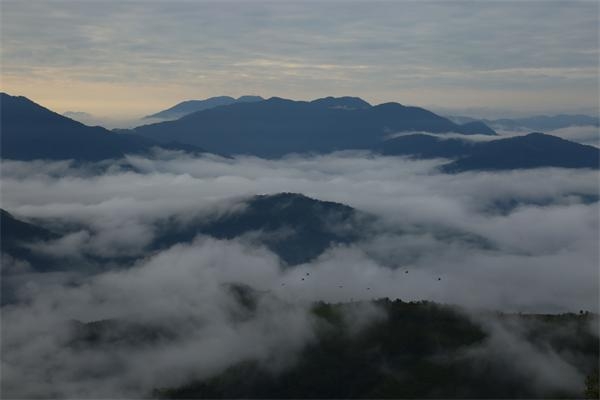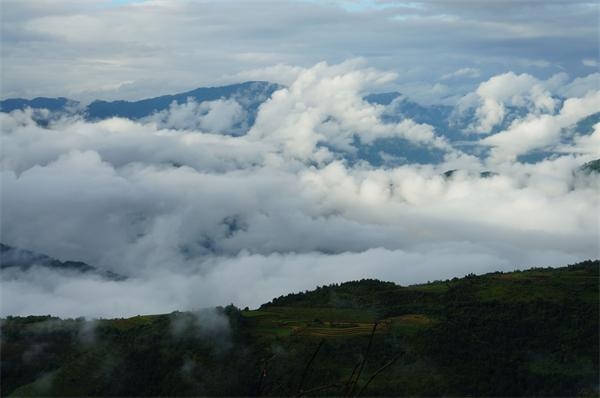Erfu Border Cloud Sea in Lvchun County, Honghe
Overview
In the new village of Erfu (二甫新村) located in Banpo Township (半坡乡) of Lvchun County (绿春县), Honghe Prefecture (红河哈尼族彝族自治州), thick fog often lingers, enveloping the village in a beautiful sea of clouds. Walking along the village roads, you can see marigolds (万寿菊) and cosmos flowers (格桑花) blooming vibrantly on either side. In the central square, the bright red five-star flag (五星红旗) flies high, symbolizing unity. Here, the Hani (哈尼族) and Lahu (拉祜族) people live together, developing their community while protecting their nation’s borders.
Erfu is situated at the southernmost point of Lvchun County, across the river from Vietnam’s national nature reserve (越南国家级自然保护区). Its unique geographic location frequently gives rise to spectacular cloud seas and breathtaking sunrises that appear to rise from the distant lands of Vietnam. Standing at a high point, one can gaze over the endless Erfu cloud sea, stretching for miles, while the Erfu sunrise presents an enchanting display.
Visitors can also explore the Lahu Ethnic Village (拉祜民族村) to witness the Lahu people’s leap from primitive society to socialism over the past half-century and to experience remnants of their traditional lifestyles.
Scenic Features
Ethereal Landscapes
The Erfu area boasts magnificent sunrise views and an illusion of a cloud sea stretching for thousands of miles, reminiscent of a fairyland, truly breathtaking. The village itself is located between the boundary markers 18 and 19 of the Vietnam-China border.
Cultural Evolution
In recent years, the Banpo Border Police Station has actively innovated and enriched the “Fengqiao Experience” (枫桥经验) for the new era. Focusing on ideas such as “Building Borders with Thoughts, Organizing to Strengthen Borders, Enriching the People, Co-building Stability, and Collaborative Governance,” they have identified effective points of service for local development, livelihood, and community support. This has enabled Erfu Village to transform from a previously impoverished area into a well-known border village with a prosperous community.
Economic Development
With the deepening of modern border happiness village construction, a beautiful, harmonious, and livable rural landscape of ethnic unity is gradually unfolding. Li Doucai (李斗才), a Hani craftsman in his forties, is a skilled weaver who has been crafting drum stools (鼓凳) for over 20 years. “The drum stool is our village’s pillar industry. I produce over 400 each year, earning around 20,000 to 30,000 CNY annually from this alone,” he shares, deftly weaving bamboo strips into the circular base of a drum stool.
In 2011 and 2012, the Hani and Lahu people relocated to Erfu New Village, where they now live harmoniously, learning from each other and developing together.
Innovative Industry Models
Seizing the opportunities of modern border happiness village construction, Banpo Township has effectively utilized the traditional drum stool weaving skills passed down through generations of Hani people. They have developed an industrial model of “Party Organization + Weaving Association + Farmers,” providing 200,000 CNY in revolving support funds to boost the bamboo and rattan weaving industry, helping residents increase their incomes. Today, the drum stool industry has become one of the primary sources of income for the residents of Erfu New Village.
Environmental Enhancements
Alongside industrial growth, environmental beautification is paramount. To transform Erfu New Village into a scenic highlight along the border, local authorities have actively implemented residential environment enhancement projects. They have mobilized party members and community members to clear 45 acres of construction land, dismantling 1,800 illegal structures such as pig pens, drying rooms, and firewood sheds. Over 5,000 person-times were invested in building over 6,000 square meters of small gardens, orchards, vegetable patches, courtyards, and squares, significantly enhancing the village’s aesthetic appeal.
In 2022, Erfu New Village was awarded the title of “Boutique Village” in Yunnan Province’s rural revitalization “Hundred-Thousand-Ten Thousand” project. The village committee achieved the goal of “Every village has industry, every household has a business,” with an average annual net income of 16,600 CNY per person.
How to Get There
- By Bus: You can take a bus from Kunming (昆明) to Honghe (红河). Buses operate frequently, with travel time around 6-8 hours.
- Local Transport: From Honghe, you can find mini-buses or taxis heading to Lvchun County (绿春县), which is approximately 30 kilometers away.
- Private Car: Renting a car is also an option, allowing you to explore the scenic areas at your own pace.
Travel Tips
- Best Time to Visit: The ideal times to visit are during early morning hours for sunrise views or when the fog is present, typically in late spring and early autumn.
- Photography: Bring your camera to capture the stunning landscapes, especially during sunrises and sunsets.
- Respect Local Customs: Engage respectfully with the Hani and Lahu communities, and be aware of local traditions and practices.
- Health Precautions: If you’re not accustomed to high altitudes, ensure you stay hydrated and take it easy upon arrival.
- Explore Local Cuisine: Don’t miss out on trying local Hani and Lahu dishes, which reflect the rich cultural heritage of the area.
- Community Involvement: If possible, participate in local crafts or cultural activities to enhance your experience and support the community.






















